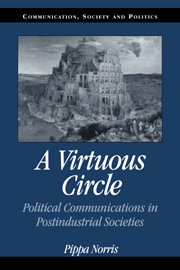Book contents
- Frontmatter
- Contents
- List of Tables
- List of Figures
- Preface
- PART I THE NEWS MEDIA AND CIVIC MALAISE
- 1 The News Media and Democracy
- 2 Evaluating Media Performance
- 3 Understanding Political Communications
- PART II TRENDS IN POLITICAL COMMUNICATIONS
- PART III THE IMPACT ON DEMOCRACY
- CONCLUSIONS
- Technical Appendix
- Notes
- Select Bibliography
- Author Index
- Subject Index
3 - Understanding Political Communications
Published online by Cambridge University Press: 26 February 2010
- Frontmatter
- Contents
- List of Tables
- List of Figures
- Preface
- PART I THE NEWS MEDIA AND CIVIC MALAISE
- 1 The News Media and Democracy
- 2 Evaluating Media Performance
- 3 Understanding Political Communications
- PART II TRENDS IN POLITICAL COMMUNICATIONS
- PART III THE IMPACT ON DEMOCRACY
- CONCLUSIONS
- Technical Appendix
- Notes
- Select Bibliography
- Author Index
- Subject Index
Summary
Although there is an abundance of heated rhetoric and conjecture, and everyone who watches television seems to have a view about the issue, it has been surprisingly difficult to find systematic evidence that proves the media malaise hypothesis. There is a broad consensus that the process of political communication has changed, but it remains questionable whether this has had a major impact on the contents of election news, still less influenced public attitudes and behavior. Unfortunately, discussions of the perceived problems of the news media often fail to distinguish between criticisms based on unsystematic observations and those based on more solid ground. Many recent books on the news media, in discussing phenomena such as trends towards ‘soft’ or ‘infotainment’ news, have simply assumed that the content of news coverage must influence the public, in a simple ‘hypodermic-syringe model’, with no prior evidence. But this model has been largely abandoned in communications research as we have come to realize that the public actively react to, deconstruct, and interpret what they watch and read, rather than simply absorbing messages like passive sponges. The attempt to understand the political influence of the news media raises difficult theoretical and methodological challenges. Previous studies exploring whether political coverage in the news media contributes towards civic malaise have generally employed trend analysis, experimental designs, or cross-sectional surveys, and each of those methods has certain advantages and disadvantages.
- Type
- Chapter
- Information
- A Virtuous CirclePolitical Communications in Postindustrial Societies, pp. 36 - 60Publisher: Cambridge University PressPrint publication year: 2000



